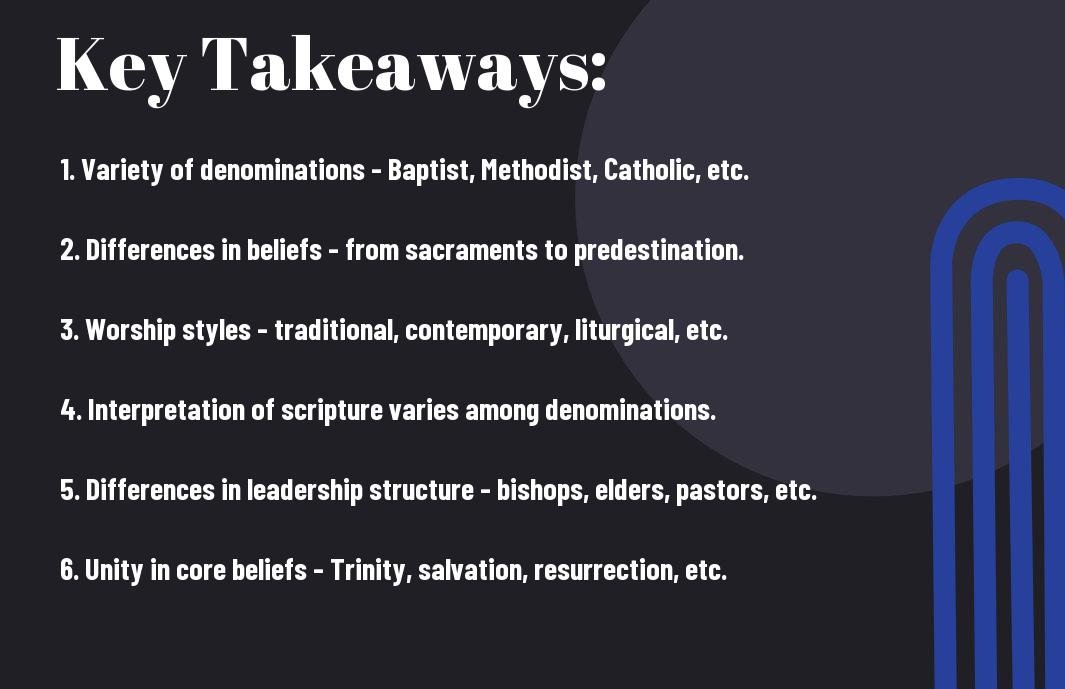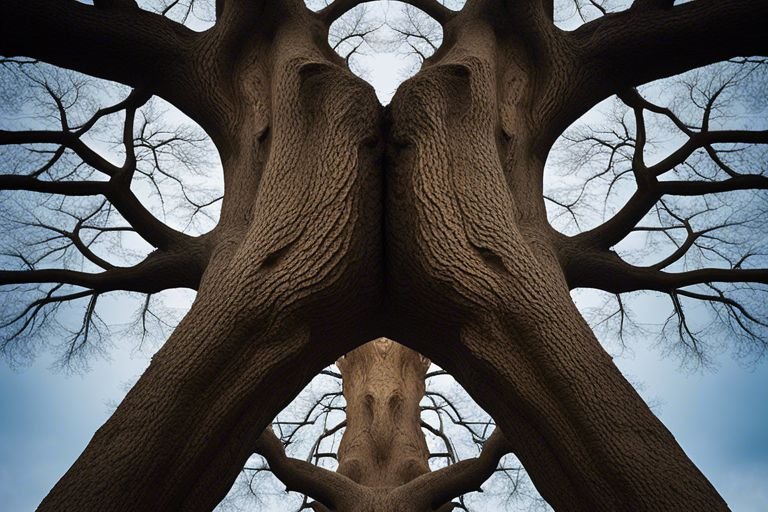Perplexed by the myriad of Christian denominations in the United States? In this blog post, I will provide an overview of the various branches of Christianity in the US and their core beliefs. From Catholicism to Protestantism, and Eastern Orthodoxy to Mormonism, the Christian faith is diverse and complex, encompassing a wide range of traditions, practices, and theological beliefs. I will delve into the key doctrinal differences between these denominations and their impact on American society, as well as the historical and cultural significance of these branches of Christianity. Whether you are a curious observer or a devout believer, this post will shed light on the rich tapestry of Christian faith in the US and deepen your understanding of its various denominations.
Key Takeaways:
- Diversity of Beliefs: There are numerous denominations of Christianity in the US, each with its own unique set of beliefs and practices.
- Main Branches: The main branches of Christianity in the US include Protestantism, Roman Catholicism, and Eastern Orthodoxy.
- Protestantism: Protestant denominations are diverse and include Baptist, Lutheran, Methodist, and Presbyterian, among others.
- Roman Catholicism: Roman Catholic Church is the largest Christian denomination in the US, with a strong emphasis on tradition and the authority of the Pope.
- Eastern Orthodoxy: Eastern Orthodox Church is known for its rich liturgical tradition and emphasis on mysticism.
The History of Christianity in the US
Before I delve into the denominations of Christianity in the US, I think it’s important to understand the historical context in which these denominations developed and thrived. Christianity has a rich and complex history in the United States, evolving alongside the country itself. From the early influences of European settlers to the waves of immigration that brought diverse Christian beliefs to our shores, the history of Christianity in the US is a story of growth, change, and adaptation.
Early Denominations
In the early days of American history, Christianity was largely dominated by Protestant denominations such as the Puritans, Anglicans, Quakers, and Congregationalists. These early denominations played a significant role in shaping the religious landscape of the country, with many of their beliefs and practices still influencing modern Christian denominations. The religious diversity among these early settlers laid the groundwork for a vibrant tapestry of Christian beliefs that continues to characterize the US today.
Waves of Immigration and Denominational Growth
As the US experienced waves of immigration from various parts of the world, the religious landscape expanded and diversified significantly. The 19th and early 20th centuries saw a surge in Catholic, Orthodox, and Protestant denominations as immigrants brought their religious beliefs and practices with them. This rapid growth and diversification of denominations have had a profound impact on the religious makeup of the US, enriching our country’s cultural and religious heritage while also sparking tensions and conflicts between different Christian groups. The waves of immigration brought about a new era of denominational growth and expansion, contributing to the vibrant and diverse Christian landscape we see in the US today.
Major Christian Denominations in the US
Assuming that you’re familiar with the basic history and beliefs of Christianity, it’s important to note that there are several major denominations within the faith, each with its own unique practices and traditions. In the United States, Christianity is overwhelmingly dominated by Roman Catholicism and various forms of Protestantism. These two branches make up the majority of Christians in the country, with a significant presence from other denominations as well.
Roman Catholicism
When it comes to Roman Catholicism, the church is led by the Pope in Rome and holds to a number of key beliefs including the importance of the sacraments, the Virgin Mary, and the authority of tradition alongside scripture. Roman Catholicism is known for its adherence to a strict moral code as well as its traditional liturgical practices, both of which can be seen as either positive or negative depending on your perspective. The church also has a rich history of social justice work and charitable efforts, although it has faced criticism for its handling of various scandals and issues over the years.
Protestantism
As for Protestantism, this branch of Christianity encompasses a wide range of denominations, each with its own unique beliefs and practices. Although there is great diversity within Protestantism, some key beliefs include the emphasis on the authority of scripture, salvation by faith alone, priesthood of all believers, and the rejection of the Pope’s authority. The Protestant tradition has been a driving force in shaping American history and culture, and it continues to play a significant role in the country today. However, it’s important to note that there are divisions and disagreements within Protestantism that have led to many different denominations and even schisms over the centuries.
Beliefs and Practices in Different Christian Denominations
For many people, the beliefs and practices of different Christian denominations can be confusing to understand. However, gaining insight into the unique aspects of each denomination can help you appreciate the diversity within the Christian faith. In this chapter, I will explore some of the key differences in beliefs and practices among various Christian denominations in the US.
Sacraments and Worship
In some denominations such as Catholicism and Eastern Orthodoxy, sacraments play a central role in worship and spiritual life. These sacraments, which include baptism, Eucharist, and confession, are considered to be vital channels of God’s grace. In contrast, Protestant denominations often have fewer sacraments and interpret them in different ways. Worship styles also vary widely among denominations, ranging from traditional liturgical services to contemporary praise and worship gatherings.
Leadership and Organizational Structure
The organizational structure and leadership hierarchy of Christian denominations can differ significantly. Some denominations, particularly the more hierarchical ones, have a strong emphasis on centralized authority, with bishops and other leaders holding considerable power. In contrast, many Protestant denominations operate with a more decentralized structure, allowing for greater autonomy and decision-making at the local level. Each approach has its strengths and drawbacks, and the differences can impact the overall direction and decision-making within a denomination.

Conclusion
Following this exploration of the various denominations of Christianity in the US, it is clear that the Christian faith is diverse and multifaceted. Each branch holds its own unique beliefs and practices, contributing to the rich tapestry of Christianity as a whole. It is important for individuals to understand the differences between denominations in order to find a faith community that aligns with their personal beliefs and values. Additionally, it is crucial to recognize and respect the diversity within the Christian faith, and to engage in open dialogue and understanding with those who may hold different beliefs than your own.
FAQ
Q: What are the different denominations of Christianity in the US?
A: The main Christian denominations in the US include Protestantism, Roman Catholicism, Eastern Orthodoxy, and Mormonism.
Q: What are the beliefs of Protestantism?
A: Protestantism is a diverse group of churches that stem from the Reformation. Core beliefs include faith in Jesus Christ as the savior, the authority of the Bible, and the concept of salvation through grace alone.
Q: What are the beliefs of Roman Catholicism?
A: Roman Catholics believe in the authority of the Pope, the sacraments, the virginity of Mary, and the doctrine of transubstantiation, where the bread and wine at mass become the body and blood of Jesus Christ.
Q: What are the beliefs of Eastern Orthodoxy?
A: Eastern Orthodox Christians uphold teachings about the Holy Trinity, the Incarnation, the virginity of Mary, and the veneration of saints. They also emphasize the importance of tradition and liturgical worship.
Q: What are the beliefs of Mormonism?
A: Mormons, also known as members of The Church of Jesus Christ of Latter-day Saints, believe in the Book of Mormon as well as the Bible. They also have unique doctrines about the nature of God, the afterlife, and the concept of eternal progression.

